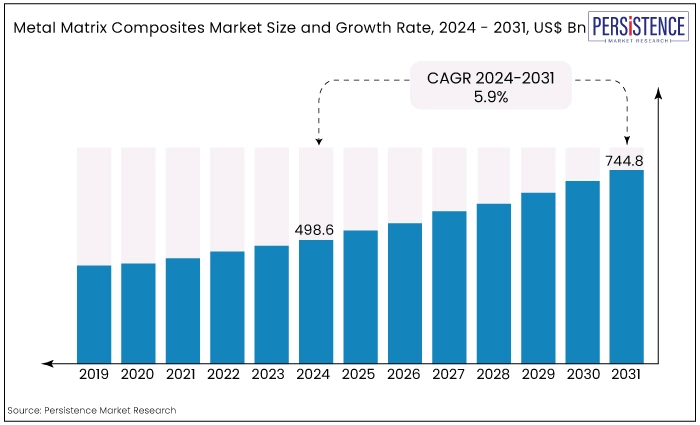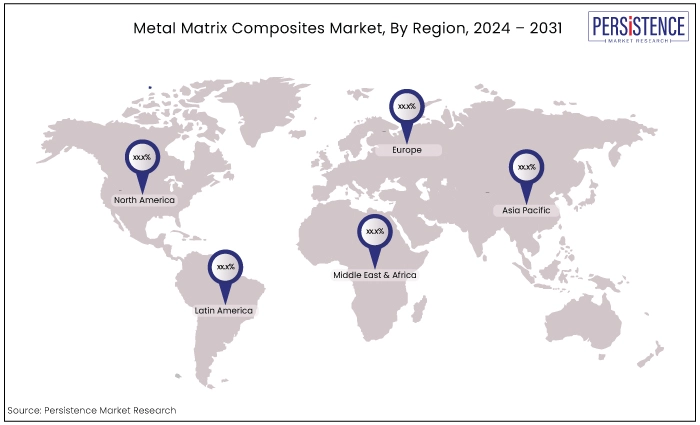Industry: Chemicals and Materials
Published Date: July-2024
Format: PPT*, PDF, EXCEL
Delivery Timelines: Contact Sales
Number of Pages: 165
Report ID: PMRREP34701
The metal matrix composites market was estimated at US$498.6 Bn in 2024 and is expected to be valued at US$744.8 Bn by 2031. The market for metal matrix composites is expected to reach a growing, steady CAGR of 5.9% from 2024 to 2031.
Key Highlights of the Market
|
Attributes |
Key Insights |
|
Market Size (2024E) |
US$ 498.6 Bn |
|
Projected Market Value (2031F) |
US$ 744.8 Bn |
|
Global Market Growth Rate (CAGR 2024 to 2031) |
5.9% |
|
Historical Market Growth Rate (CAGR 2019 to 2023) |
5.5% |
The metal matrix composites market value is growing significantly and is expected to reach a value of US$498.6 Bn in 2024 and grow at a CAGR of 5.9% to reach US$744.8 Bn by 2031.
Metal matrix composites (MMC) are materials that consist of a metal matrix reinforced with other materials, such as ceramics or fibers. These composites offer superior properties compared to traditional metals, including high strength, stiffness, and thermal conductivity, as well as improved wear resistance and lightweight characteristics.
The market is driven by the increasing demand for lightweight materials in the aerospace and defense industries, as well as the superior properties of metal matrix composites over metals.
The metal matrix composites market trends shape its growth and development. The aerospace and defense industry is a major driver of the metal matrix composite industry. The demand for lightweight and strong materials in this industry is increasing, as they offer improved fuel efficiency, reduced emissions, and enhanced performance.
The rising adoption of electric vehicles presents new opportunities for the metal matrix composites market. These composites can be used in electric vehicle components to reduce weight and improve energy efficiency. All these trends are fueling the market.

The metal matrix composites market report shows immense potential for market expansion. The market size of metal matrix composites was valued at US$381.5 Bn in 2019 and reached US$472.6 Bn at a CAGR of 5.5% from 2019 to 2023.
The historic growth of the metal matrix composites market can also be attributed to strong economic growth in emerging markets, rapid growth in the automotive industry, increasing demand for lightweight materials in the aerospace and defense industries, and government support.
Looking ahead, the metal matrix composites market shares is expected to continue its growth trajectory. The market is projected to reach US$ 498.6 Bn in 2024 and grow at a CAGR of 5.9% to reach US$ 744.8 Bn by 2031.
The increasing demand for lightweight and high-performance materials, the rising demand for refractory materials, and the growing utilization of electric vehicles (EVs) to reduce greenhouse gas emissions are some of the key factors expected to drive the market.
Additionally, ongoing research and development activities, technological advancements, and increasing industrial applications are expected to contribute to the market's growth.
Increasing Demand for Lightweight Materials
The demand for lightweight materials is a major growth driver in the MMC market. Industries such as aerospace, automotive, and defense are increasingly seeking lightweight materials to improve fuel efficiency, reduce emissions, and enhance performance.
Metal matrix composites offer excellent strength-to-weight ratio, making them an attractive choice for these industries.
Rising Need for High-Performance Materials
The need for high-performance materials is driving the metal matrix composites market demand. Industries require materials with superior properties such as high strength, stiffness, thermal conductivity, and wear resistance.
Metal matrix composites offer these enhanced properties compared to traditional metals, making them suitable for applications in critical industries like aerospace, defense, and electronics.
Expanding Applications in Emerging Industries
MMCs are finding new applications in emerging industries, such as renewable energy, electric vehicles, and medical devices. These industries demand materials that can withstand extreme conditions, provide energy efficiency, and offer improved performance.
The unique properties of MMCs, including lightweight characteristics and excellent thermal management, make them ideal for these emerging sectors, driving the metal matrix composites market growth.
Increasing Demand for Lightweight Materials
The demand for lightweight materials is a major growth driver in the MMC market. Industries such as aerospace, automotive, and defense are increasingly seeking lightweight materials to improve fuel efficiency, reduce emissions, and enhance performance.
Metal matrix composites offer excellent strength-to-weight ratio, making them an attractive choice for these industries.
Rising Need for High-Performance Materials
The need for high-performance materials is driving the metal matrix composites market demand. Industries require materials with superior properties such as high strength, stiffness, thermal conductivity, and wear resistance.
Metal matrix composites offer these enhanced properties compared to traditional metals, making them suitable for applications in critical industries like aerospace, defense, and electronics.
Expanding Applications in Emerging Industries
MMCs are finding new applications in emerging industries, such as renewable energy, electric vehicles, and medical devices. These industries demand materials that can withstand extreme conditions, provide energy efficiency, and offer improved performance.
The unique properties of MMCs, including lightweight characteristics and excellent thermal management, make them ideal for these emerging sectors, driving the metal matrix composites market growth.
Reduction in Ductility and Toughness
The incorporation of reinforcing materials in metal matrix composites can lead to a reduction in ductility and toughness. For example, the ductility of composites can decrease from 10% to 2% compared to the base metal.
This reduction in ductility and toughness can limit the application of MMCs in certain industries where these properties are crucial for damage tolerance and structural integrity.
Complicated Manufacturing Process
The manufacturing process of metal matrix composites is complex and requires specialized techniques and equipment. Factors such as the composition and microstructure of the matrix alloy, type and size of reinforcement, and processing conditions can affect the toughness and ductility of MMCs.
The complexity of the manufacturing process can pose challenges in terms of scalability, cost-effectiveness, and quality control, hindering the widespread adoption of MMCs.
Expansion in Renewable Energy Sector
The growing focus on renewable energy sources presents a significant opportunity for the MMC market. Metal matrix composites can be utilized in wind turbine components, such as blades and generators, to improve durability, reduce weight, and enhance energy efficiency.
As the demand for renewable energy continues to rise, the MMC market can capitalize on this opportunity by providing advanced materials that contribute to the development of more efficient and reliable renewable energy systems.
Increasing Adoption in Medical Industry
The medical industry is another promising sector for the MMC market. Metal matrix composites offer advantages such as biocompatibility, corrosion resistance, and high strength, making them suitable for applications in orthopedic implants, dental devices, and surgical instruments.
With advancements in medical technology and an aging population, there is a growing demand for innovative materials that can improve patient outcomes and enhance medical device performance, providing a favorable opportunity for MMCs to make significant inroads in the medical industry.
Automotive Industry Takes the Wheel in Metal Matrix Composites market
Based on end-use, the automotive segment dominates the market due to the growing utilization of MMCs in applications such as brake pads, brake drums, and rail brake discs, offering superior properties.
The increasing demand for automotive and passenger vehicles is expected to drive the need for high-performance MMCs in the transportation sector. Additionally, MMC finds increased applications in railway coaches and locomotives, reducing maintenance costs and power consumption.
Aluminum Reigns Supreme in Product Segment
The metal matrix composites market is segmented based on product type, including aluminum, nickel, refractory, copper, and others. Aluminum dominates the market due to its exceptional combination of properties, such as high strength, lightweight nature, excellent thermal conductivity, and good corrosion resistance.
These qualities make aluminum MMCs highly sought after in industries like aerospace, automotive, and defense. Additionally, aluminum is widely available and relatively cost-effective compared to alternative materials like nickel or refractory metals, contributing to boosting metal matrix composites market shares.
North America at the Forefront, Automotive Industry’s Expansion Drives Growth
North America dominates the metal matrix composites market, driven by its strong presence in automotive, transportation, and aerospace industries. Major automobile and aircraft manufacturers in the US, and Canada contribute to the region's high consumption of MMC.
However, the COVID-19 pandemic has significantly impacted global demand for composites, affecting the North American automotive and aerospace sectors.
The US aerospace industry alone has already lost over US$ 200 billion in market value. Factory shutdowns, as reported by ACEA, have further compounded the challenges faced by the industry.
Asia Pacific Paves the Path for the Market with Government Support
The Asia Pacific region, with its large population, emerging economies, and increasing industrialization, presents significant growth opportunities for the metal matrix composites market.
The region's dominance in global electronics production, along with the presence of key contributor companies like South Korea, Japan, and China, drives the demand for MMCs.
Moreover, governments in the Asia Pacific region actively support the development of advanced materials and technologies through incentives, research grants, and infrastructure support, further boosting the MMC market's growth potential.

The metal matrix composites market is actively pursuing growth opportunities by acquiring established players and promoting innovation. This trend is reinforced by the emergence of start-ups that bring unique offerings, creating a dynamic and competitive market landscape.
Companies are making substantial investments to expand production capabilities and enhance technological features, aiming to develop innovative functionalities and seamlessly integrate technologies into this evolving sector. By doing so, they are striving for successful market entry and widespread adoption, while staying ahead of evolving trends in the industry.
Recent Industry Developments
Currently, aircraft are made of 50% metal components, but TISICS is offering a sustainable alternative by replacing these metal components with lightweight and high-strength metal matrix composites. Light Land is the world's largest metal matrix composite component for commercial aircraft, demonstrating improved fuel efficiency and reducing carbon emissions.
Toyota's 2023 patents showcase the company's wide-ranging innovations, including the Kinetic Seat Cushion for Vehicles, a lightweight carbon fiber reinforced steel matrix composite, and Systems and Methods with Dual Function Coil Providing In-vehicle Wireless Power. Toyota is spending approximately $1 million per hour on R&D to develop cutting-edge, high-quality vehicles and technologies.
|
Attributes |
Details |
|
Forecast Period |
2024 to 2031 |
|
Historical Data Available for |
2019 to 2023 |
|
Market Analysis |
US$ Billion for Value |
|
Key Country Covered |
|
|
Key Market Segments Covered |
|
|
Key Companies Profiled |
|
|
Report Coverage |
|
|
Customization & Pricing |
Available upon request |
By Matrix Material
By Reinforcement Type
By Reinforcement Material
By Production Technology
By End-Use Industry
By Geographical Regions
To know more about delivery timeline for this report Contact Sales

The market is predicted to rise from US$ 498.6 Bn in 2024 to US$ 744.8 Bn by 2031.
Awareness about the superior properties of MMCs in the aerospace and defense industries, as well as their increasing use in locomotives and electric vehicles, are propelling the market growth.
The major companies operating in the metal matrix composites market include Materion Corporation, GKN Sinter Metals Engineering GmbH, 3M, CPS Technologies Corp., and Sumitomo Electric Industries, Ltd.
Challenges like reduction in ductility and toughness and complex manufacturing processes are restraining market expansion.
Growing focus on renewable energy sources and growing demand in the medical industry are creating opportunities in the market.